Management Accounting Budgets and Financial Planning
VerifiedAdded on 2020/10/23
|8
|1585
|214
AI Summary
This assignment provides a comprehensive example of management accounting budgets, covering sales budget, inventory budget, labor budget, and loan received. The tables included in the assignment demonstrate the calculation of various financial metrics, such as total A, payments, fixed expenses, variable expenses, instalment, total B, closing balance, and A-B values. This resource is suitable for students looking to understand management accounting budgets and their applications.
Contribute Materials
Your contribution can guide someone’s learning journey. Share your
documents today.
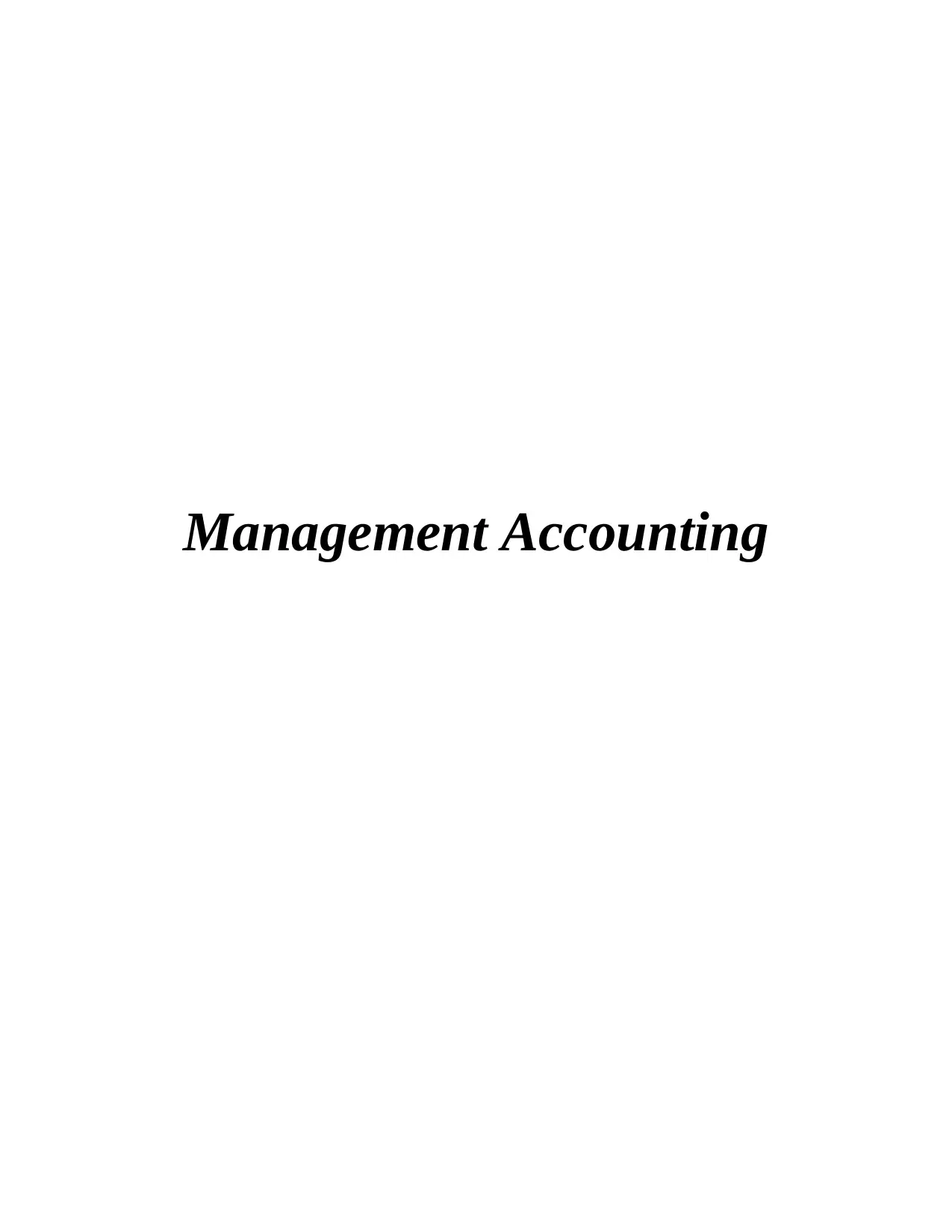
Management Accounting
Secure Best Marks with AI Grader
Need help grading? Try our AI Grader for instant feedback on your assignments.
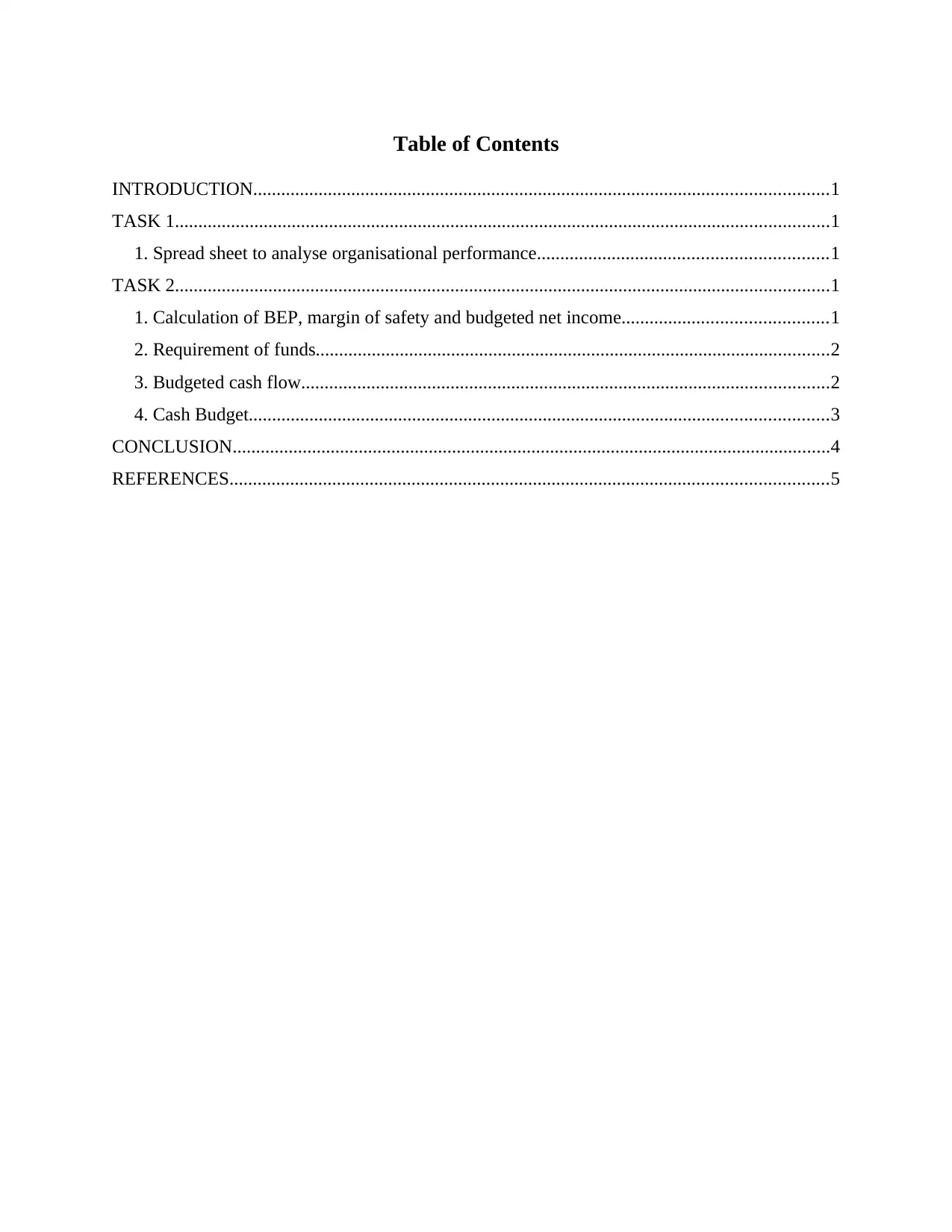
Table of Contents
INTRODUCTION...........................................................................................................................1
TASK 1............................................................................................................................................1
1. Spread sheet to analyse organisational performance..............................................................1
TASK 2............................................................................................................................................1
1. Calculation of BEP, margin of safety and budgeted net income............................................1
2. Requirement of funds..............................................................................................................2
3. Budgeted cash flow.................................................................................................................2
4. Cash Budget............................................................................................................................3
CONCLUSION................................................................................................................................4
REFERENCES................................................................................................................................5
INTRODUCTION...........................................................................................................................1
TASK 1............................................................................................................................................1
1. Spread sheet to analyse organisational performance..............................................................1
TASK 2............................................................................................................................................1
1. Calculation of BEP, margin of safety and budgeted net income............................................1
2. Requirement of funds..............................................................................................................2
3. Budgeted cash flow.................................................................................................................2
4. Cash Budget............................................................................................................................3
CONCLUSION................................................................................................................................4
REFERENCES................................................................................................................................5
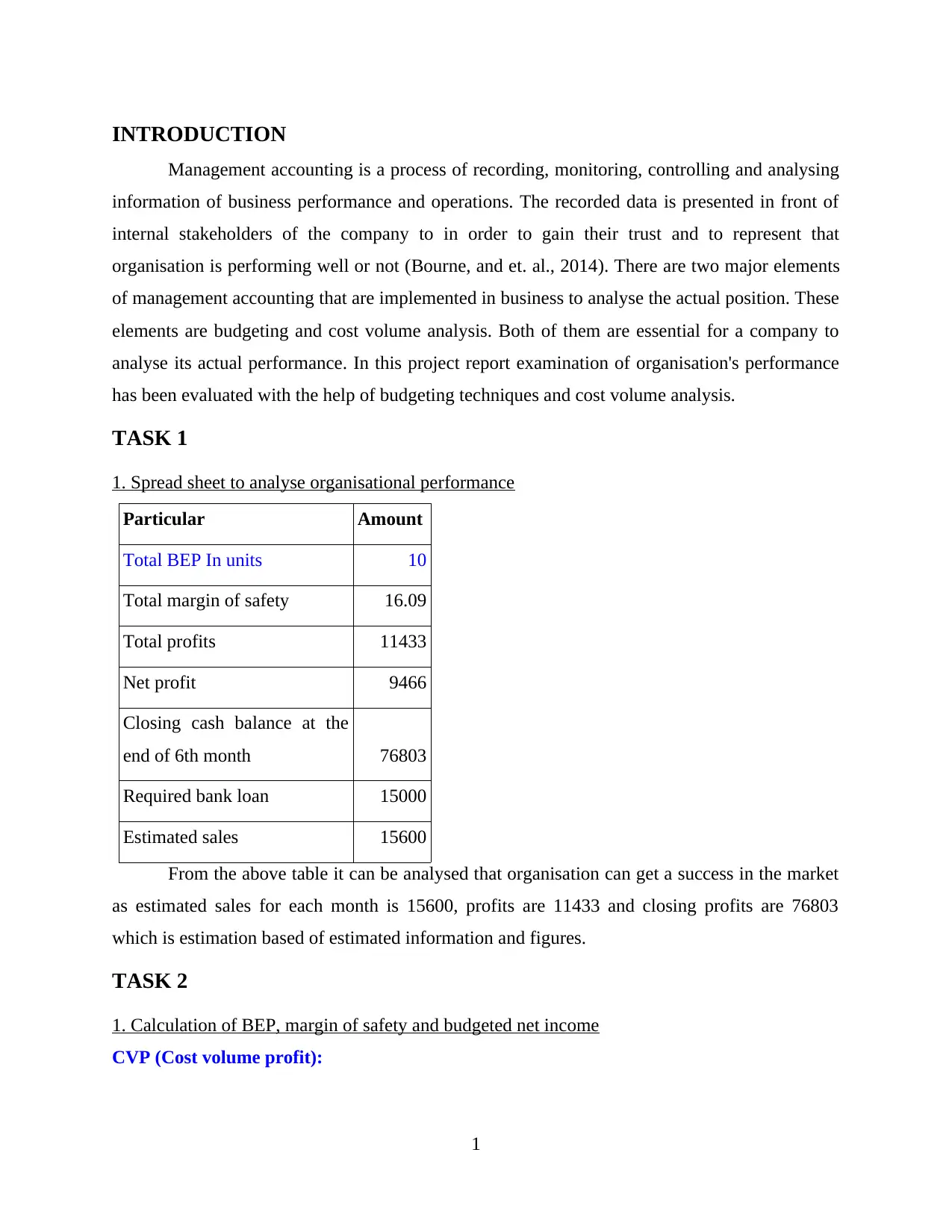
INTRODUCTION
Management accounting is a process of recording, monitoring, controlling and analysing
information of business performance and operations. The recorded data is presented in front of
internal stakeholders of the company to in order to gain their trust and to represent that
organisation is performing well or not (Bourne, and et. al., 2014). There are two major elements
of management accounting that are implemented in business to analyse the actual position. These
elements are budgeting and cost volume analysis. Both of them are essential for a company to
analyse its actual performance. In this project report examination of organisation's performance
has been evaluated with the help of budgeting techniques and cost volume analysis.
TASK 1
1. Spread sheet to analyse organisational performance
Particular Amount
Total BEP In units 10
Total margin of safety 16.09
Total profits 11433
Net profit 9466
Closing cash balance at the
end of 6th month 76803
Required bank loan 15000
Estimated sales 15600
From the above table it can be analysed that organisation can get a success in the market
as estimated sales for each month is 15600, profits are 11433 and closing profits are 76803
which is estimation based of estimated information and figures.
TASK 2
1. Calculation of BEP, margin of safety and budgeted net income
CVP (Cost volume profit):
1
Management accounting is a process of recording, monitoring, controlling and analysing
information of business performance and operations. The recorded data is presented in front of
internal stakeholders of the company to in order to gain their trust and to represent that
organisation is performing well or not (Bourne, and et. al., 2014). There are two major elements
of management accounting that are implemented in business to analyse the actual position. These
elements are budgeting and cost volume analysis. Both of them are essential for a company to
analyse its actual performance. In this project report examination of organisation's performance
has been evaluated with the help of budgeting techniques and cost volume analysis.
TASK 1
1. Spread sheet to analyse organisational performance
Particular Amount
Total BEP In units 10
Total margin of safety 16.09
Total profits 11433
Net profit 9466
Closing cash balance at the
end of 6th month 76803
Required bank loan 15000
Estimated sales 15600
From the above table it can be analysed that organisation can get a success in the market
as estimated sales for each month is 15600, profits are 11433 and closing profits are 76803
which is estimation based of estimated information and figures.
TASK 2
1. Calculation of BEP, margin of safety and budgeted net income
CVP (Cost volume profit):
1
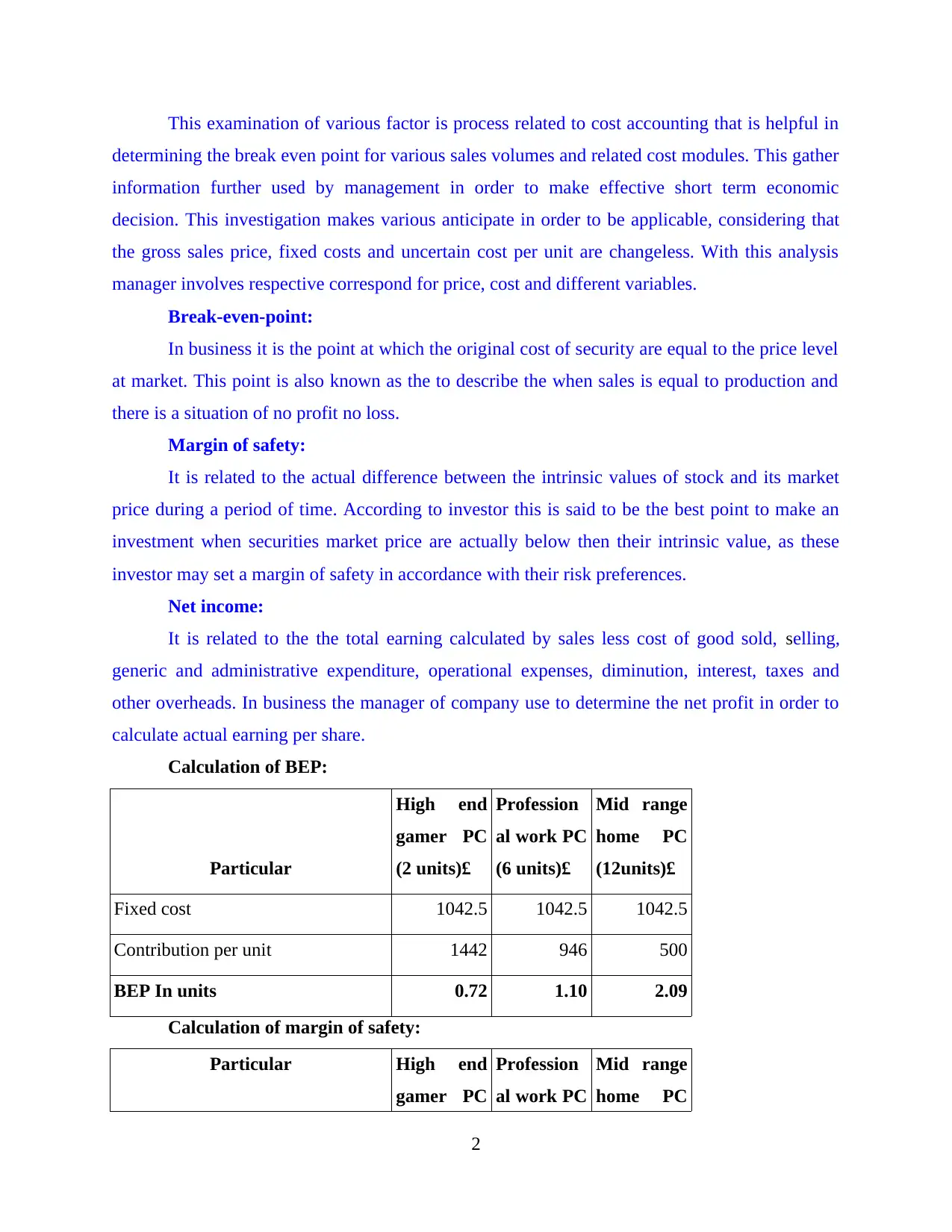
This examination of various factor is process related to cost accounting that is helpful in
determining the break even point for various sales volumes and related cost modules. This gather
information further used by management in order to make effective short term economic
decision. This investigation makes various anticipate in order to be applicable, considering that
the gross sales price, fixed costs and uncertain cost per unit are changeless. With this analysis
manager involves respective correspond for price, cost and different variables.
Break-even-point:
In business it is the point at which the original cost of security are equal to the price level
at market. This point is also known as the to describe the when sales is equal to production and
there is a situation of no profit no loss.
Margin of safety:
It is related to the actual difference between the intrinsic values of stock and its market
price during a period of time. According to investor this is said to be the best point to make an
investment when securities market price are actually below then their intrinsic value, as these
investor may set a margin of safety in accordance with their risk preferences.
Net income:
It is related to the the total earning calculated by sales less cost of good sold, selling,
generic and administrative expenditure, operational expenses, diminution, interest, taxes and
other overheads. In business the manager of company use to determine the net profit in order to
calculate actual earning per share.
Calculation of BEP:
Particular
High end
gamer PC
(2 units)£
Profession
al work PC
(6 units)£
Mid range
home PC
(12units)£
Fixed cost 1042.5 1042.5 1042.5
Contribution per unit 1442 946 500
BEP In units 0.72 1.10 2.09
Calculation of margin of safety:
Particular High end
gamer PC
Profession
al work PC
Mid range
home PC
2
determining the break even point for various sales volumes and related cost modules. This gather
information further used by management in order to make effective short term economic
decision. This investigation makes various anticipate in order to be applicable, considering that
the gross sales price, fixed costs and uncertain cost per unit are changeless. With this analysis
manager involves respective correspond for price, cost and different variables.
Break-even-point:
In business it is the point at which the original cost of security are equal to the price level
at market. This point is also known as the to describe the when sales is equal to production and
there is a situation of no profit no loss.
Margin of safety:
It is related to the actual difference between the intrinsic values of stock and its market
price during a period of time. According to investor this is said to be the best point to make an
investment when securities market price are actually below then their intrinsic value, as these
investor may set a margin of safety in accordance with their risk preferences.
Net income:
It is related to the the total earning calculated by sales less cost of good sold, selling,
generic and administrative expenditure, operational expenses, diminution, interest, taxes and
other overheads. In business the manager of company use to determine the net profit in order to
calculate actual earning per share.
Calculation of BEP:
Particular
High end
gamer PC
(2 units)£
Profession
al work PC
(6 units)£
Mid range
home PC
(12units)£
Fixed cost 1042.5 1042.5 1042.5
Contribution per unit 1442 946 500
BEP In units 0.72 1.10 2.09
Calculation of margin of safety:
Particular High end
gamer PC
Profession
al work PC
Mid range
home PC
2
Secure Best Marks with AI Grader
Need help grading? Try our AI Grader for instant feedback on your assignments.
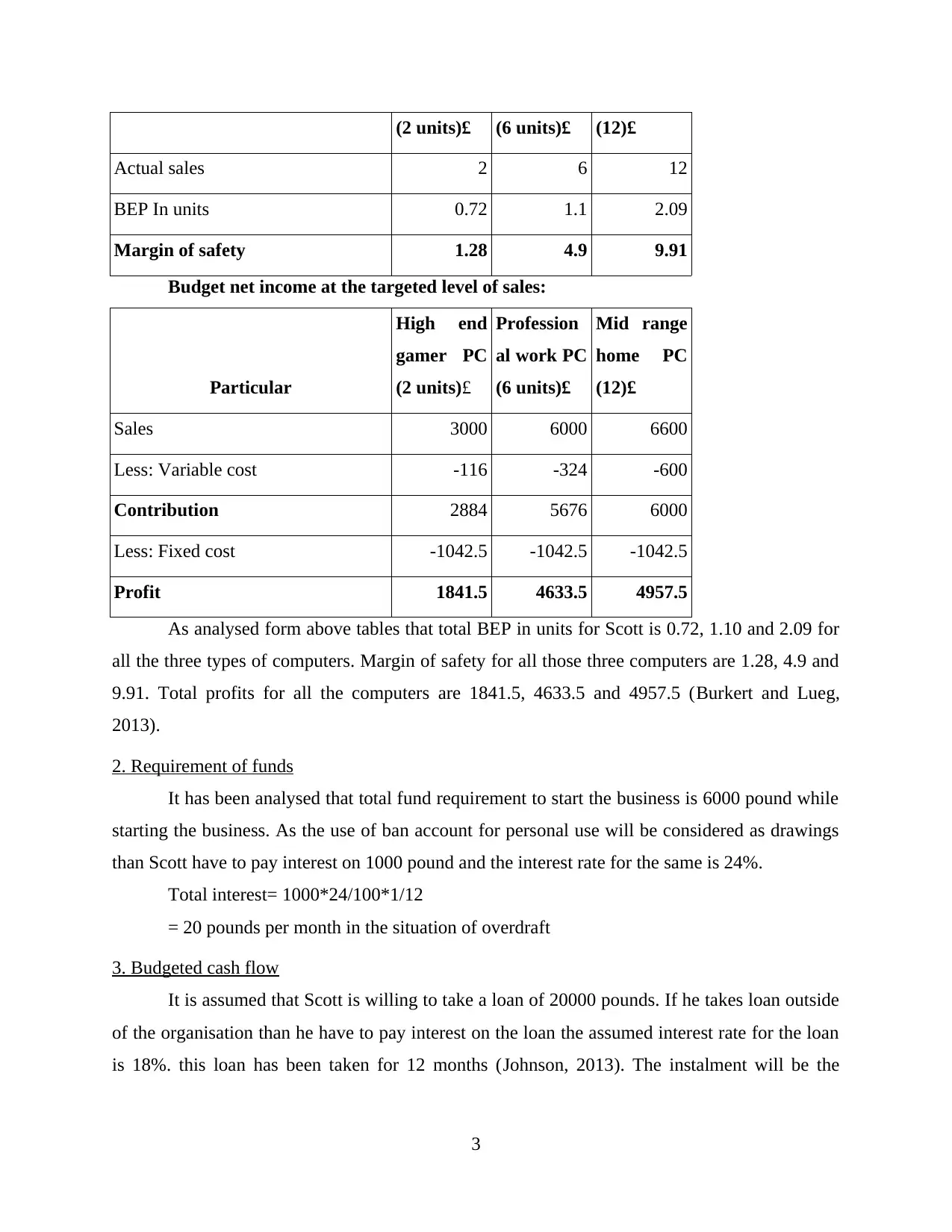
(2 units)£ (6 units)£ (12)£
Actual sales 2 6 12
BEP In units 0.72 1.1 2.09
Margin of safety 1.28 4.9 9.91
Budget net income at the targeted level of sales:
Particular
High end
gamer PC
(2 units)£
Profession
al work PC
(6 units)£
Mid range
home PC
(12)£
Sales 3000 6000 6600
Less: Variable cost -116 -324 -600
Contribution 2884 5676 6000
Less: Fixed cost -1042.5 -1042.5 -1042.5
Profit 1841.5 4633.5 4957.5
As analysed form above tables that total BEP in units for Scott is 0.72, 1.10 and 2.09 for
all the three types of computers. Margin of safety for all those three computers are 1.28, 4.9 and
9.91. Total profits for all the computers are 1841.5, 4633.5 and 4957.5 (Burkert and Lueg,
2013).
2. Requirement of funds
It has been analysed that total fund requirement to start the business is 6000 pound while
starting the business. As the use of ban account for personal use will be considered as drawings
than Scott have to pay interest on 1000 pound and the interest rate for the same is 24%.
Total interest= 1000*24/100*1/12
= 20 pounds per month in the situation of overdraft
3. Budgeted cash flow
It is assumed that Scott is willing to take a loan of 20000 pounds. If he takes loan outside
of the organisation than he have to pay interest on the loan the assumed interest rate for the loan
is 18%. this loan has been taken for 12 months (Johnson, 2013). The instalment will be the
3
Actual sales 2 6 12
BEP In units 0.72 1.1 2.09
Margin of safety 1.28 4.9 9.91
Budget net income at the targeted level of sales:
Particular
High end
gamer PC
(2 units)£
Profession
al work PC
(6 units)£
Mid range
home PC
(12)£
Sales 3000 6000 6600
Less: Variable cost -116 -324 -600
Contribution 2884 5676 6000
Less: Fixed cost -1042.5 -1042.5 -1042.5
Profit 1841.5 4633.5 4957.5
As analysed form above tables that total BEP in units for Scott is 0.72, 1.10 and 2.09 for
all the three types of computers. Margin of safety for all those three computers are 1.28, 4.9 and
9.91. Total profits for all the computers are 1841.5, 4633.5 and 4957.5 (Burkert and Lueg,
2013).
2. Requirement of funds
It has been analysed that total fund requirement to start the business is 6000 pound while
starting the business. As the use of ban account for personal use will be considered as drawings
than Scott have to pay interest on 1000 pound and the interest rate for the same is 24%.
Total interest= 1000*24/100*1/12
= 20 pounds per month in the situation of overdraft
3. Budgeted cash flow
It is assumed that Scott is willing to take a loan of 20000 pounds. If he takes loan outside
of the organisation than he have to pay interest on the loan the assumed interest rate for the loan
is 18%. this loan has been taken for 12 months (Johnson, 2013). The instalment will be the
3
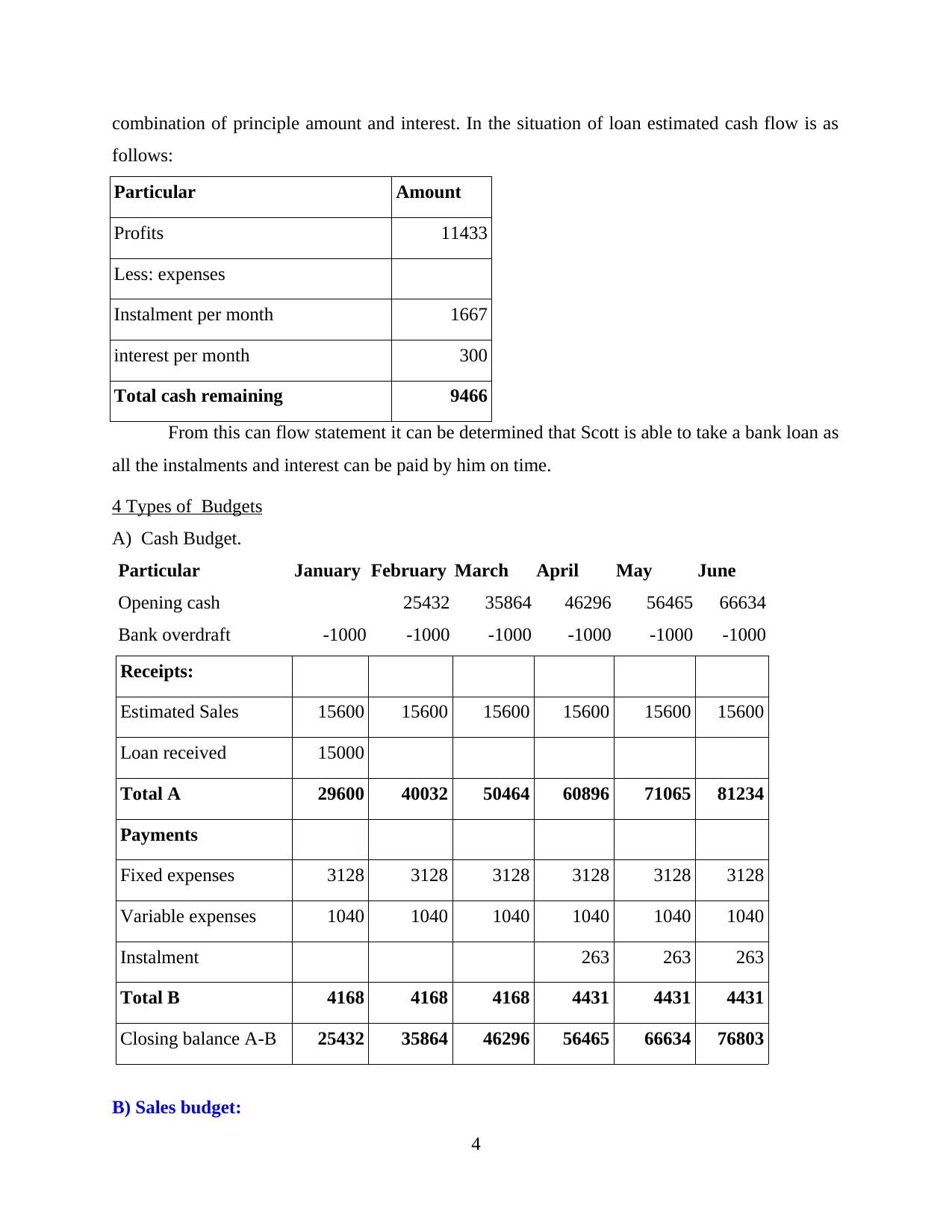
combination of principle amount and interest. In the situation of loan estimated cash flow is as
follows:
Particular Amount
Profits 11433
Less: expenses
Instalment per month 1667
interest per month 300
Total cash remaining 9466
From this can flow statement it can be determined that Scott is able to take a bank loan as
all the instalments and interest can be paid by him on time.
4 Types of Budgets
A) Cash Budget.
Particular January February March April May June
Opening cash 25432 35864 46296 56465 66634
Bank overdraft -1000 -1000 -1000 -1000 -1000 -1000
Receipts:
Estimated Sales 15600 15600 15600 15600 15600 15600
Loan received 15000
Total A 29600 40032 50464 60896 71065 81234
Payments
Fixed expenses 3128 3128 3128 3128 3128 3128
Variable expenses 1040 1040 1040 1040 1040 1040
Instalment 263 263 263
Total B 4168 4168 4168 4431 4431 4431
Closing balance A-B 25432 35864 46296 56465 66634 76803
B) Sales budget:
4
follows:
Particular Amount
Profits 11433
Less: expenses
Instalment per month 1667
interest per month 300
Total cash remaining 9466
From this can flow statement it can be determined that Scott is able to take a bank loan as
all the instalments and interest can be paid by him on time.
4 Types of Budgets
A) Cash Budget.
Particular January February March April May June
Opening cash 25432 35864 46296 56465 66634
Bank overdraft -1000 -1000 -1000 -1000 -1000 -1000
Receipts:
Estimated Sales 15600 15600 15600 15600 15600 15600
Loan received 15000
Total A 29600 40032 50464 60896 71065 81234
Payments
Fixed expenses 3128 3128 3128 3128 3128 3128
Variable expenses 1040 1040 1040 1040 1040 1040
Instalment 263 263 263
Total B 4168 4168 4168 4431 4431 4431
Closing balance A-B 25432 35864 46296 56465 66634 76803
B) Sales budget:
4
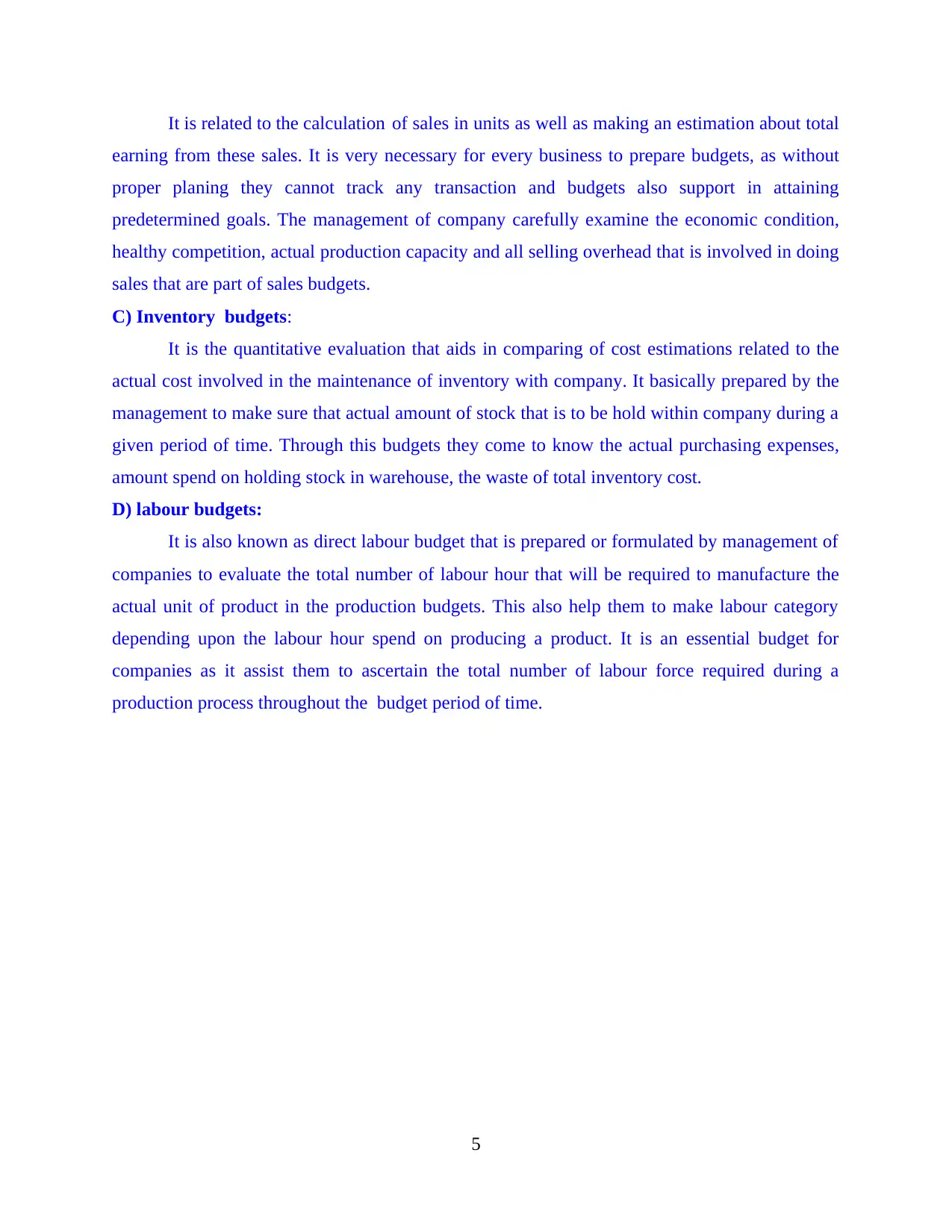
It is related to the calculation of sales in units as well as making an estimation about total
earning from these sales. It is very necessary for every business to prepare budgets, as without
proper planing they cannot track any transaction and budgets also support in attaining
predetermined goals. The management of company carefully examine the economic condition,
healthy competition, actual production capacity and all selling overhead that is involved in doing
sales that are part of sales budgets.
C) Inventory budgets:
It is the quantitative evaluation that aids in comparing of cost estimations related to the
actual cost involved in the maintenance of inventory with company. It basically prepared by the
management to make sure that actual amount of stock that is to be hold within company during a
given period of time. Through this budgets they come to know the actual purchasing expenses,
amount spend on holding stock in warehouse, the waste of total inventory cost.
D) labour budgets:
It is also known as direct labour budget that is prepared or formulated by management of
companies to evaluate the total number of labour hour that will be required to manufacture the
actual unit of product in the production budgets. This also help them to make labour category
depending upon the labour hour spend on producing a product. It is an essential budget for
companies as it assist them to ascertain the total number of labour force required during a
production process throughout the budget period of time.
5
earning from these sales. It is very necessary for every business to prepare budgets, as without
proper planing they cannot track any transaction and budgets also support in attaining
predetermined goals. The management of company carefully examine the economic condition,
healthy competition, actual production capacity and all selling overhead that is involved in doing
sales that are part of sales budgets.
C) Inventory budgets:
It is the quantitative evaluation that aids in comparing of cost estimations related to the
actual cost involved in the maintenance of inventory with company. It basically prepared by the
management to make sure that actual amount of stock that is to be hold within company during a
given period of time. Through this budgets they come to know the actual purchasing expenses,
amount spend on holding stock in warehouse, the waste of total inventory cost.
D) labour budgets:
It is also known as direct labour budget that is prepared or formulated by management of
companies to evaluate the total number of labour hour that will be required to manufacture the
actual unit of product in the production budgets. This also help them to make labour category
depending upon the labour hour spend on producing a product. It is an essential budget for
companies as it assist them to ascertain the total number of labour force required during a
production process throughout the budget period of time.
5
Paraphrase This Document
Need a fresh take? Get an instant paraphrase of this document with our AI Paraphraser
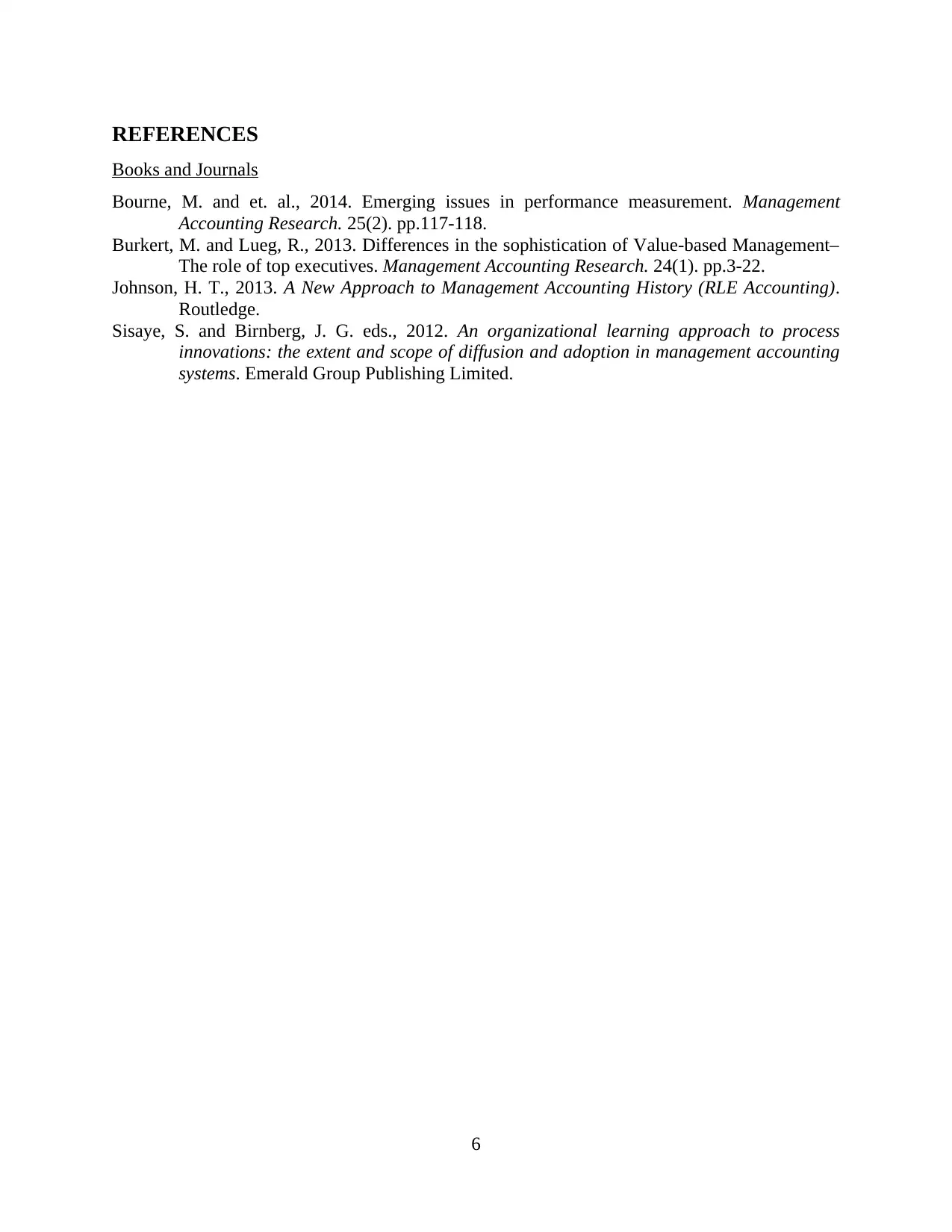
REFERENCES
Books and Journals
Bourne, M. and et. al., 2014. Emerging issues in performance measurement. Management
Accounting Research. 25(2). pp.117-118.
Burkert, M. and Lueg, R., 2013. Differences in the sophistication of Value-based Management–
The role of top executives. Management Accounting Research. 24(1). pp.3-22.
Johnson, H. T., 2013. A New Approach to Management Accounting History (RLE Accounting).
Routledge.
Sisaye, S. and Birnberg, J. G. eds., 2012. An organizational learning approach to process
innovations: the extent and scope of diffusion and adoption in management accounting
systems. Emerald Group Publishing Limited.
6
Books and Journals
Bourne, M. and et. al., 2014. Emerging issues in performance measurement. Management
Accounting Research. 25(2). pp.117-118.
Burkert, M. and Lueg, R., 2013. Differences in the sophistication of Value-based Management–
The role of top executives. Management Accounting Research. 24(1). pp.3-22.
Johnson, H. T., 2013. A New Approach to Management Accounting History (RLE Accounting).
Routledge.
Sisaye, S. and Birnberg, J. G. eds., 2012. An organizational learning approach to process
innovations: the extent and scope of diffusion and adoption in management accounting
systems. Emerald Group Publishing Limited.
6
1 out of 8
Related Documents
Your All-in-One AI-Powered Toolkit for Academic Success.
+13062052269
info@desklib.com
Available 24*7 on WhatsApp / Email
![[object Object]](/_next/static/media/star-bottom.7253800d.svg)
Unlock your academic potential
© 2024 | Zucol Services PVT LTD | All rights reserved.





